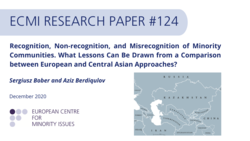ECMI Publications Database

This Research Paper focuses on practices concerning recognition and non-recognition of minority communities in six European and Central Asian countries (Denmark, Germany, Kazakhstan, Kyrgyzstan, Poland, and Tajikistan). Additionally, it also assesses the risk of misrecognition with regard to some of the minority communities resulting from these practices. The text is structured as a dual comparative analysis, first scrutinizing approaches to recognition within two macro-regions, and afterwards confronting them in order to identify similarities and discrepancies. This results in the identification of two “cultures” of recognition: a “strong” one in Europe and a “weak” one in Central Asia, with their characteristics originating mainly from differences concerning social, political, and legal contexts. At the same time, some features are shared by both macro-regions: hierarchization of minority communities, general limited access to minority rights, and sometimes a severe risk of misrecognition. Moreover, the paper argues in favour of formal mechanisms of recognition, a wider scope of application of minority rights (especially in Europe), as well as the strengthening of minority rights frameworks in Central Asia.
*** Some parts of the text were edited in June 2021.

